When a stock refuses to honor an established range, it usually reverses to break the trading range in the opposite direction, thus establishing a new pivot point. By picking a bottom, a trader can benefit by getting in early on a new trend. In this article we will discuss concepts from a long (uptrend) perspective and using stocks as the financial instrument. For shorting, apply the same concepts in reverse. These concepts will work for any instrument that can be charted, as they simply measure the psychology of the market participants.
Identifying a Partial Retrace
There are three basic trends for stocks: uptrend (moving higher), downtrend (moving lower) and consolidation (moving sideways). A stock in an uptrend is defined as making higher pivot highs, and higher pivot lows.
 | 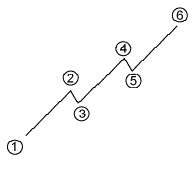 |
| Figure 1: A downtrend and an uptrend | |
| Copyright ã 2007 Investopedia.com |
A stock moving in a downtrend is defined as making lower pivot highs and lower pivot lows. A stock moving sideways is defined as moving in a trading range making pivot highs and lows approximately along the same horizontal area on a chart. Pivot points can be a little higher or lower, but generally speaking, the stock is trending sideways. It is important to note that a consolidation base can also slope upwards or downwards.
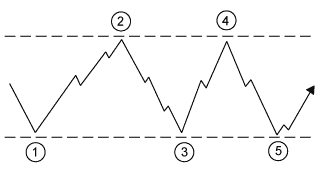 |
| Figure 2: Sideways trend |
| Copyright ã 2007 Investopedia.com |
While a partial retrace can be defined as anytime a stock retraces only a portion of its prior move, this discussion will concentrate on stocks getting ready to move out of a consolidation base. Often, when a stock is consolidating, it is moving in a trading range, as supply and demand are in equilibrium. As a stock rises to the top of the range, sellers step in thinking the stock is getting expensive. As it drifts to the bottom of the trading range, buyers step in thinking the stock is becoming a bargain. This type of trend is necessary in order to weed out participants who are not committed to the position. The trading range will stay in place until either supply or demand triumphs. Typically, the trend prior to the consolidation is continued; however, there is always the possibility of a reversal. (To learn more, read Retracement Or Reversal: Know The Difference, Market Reversals And How To Spot Them and Support And Resistance Reversals.)
Beating a Breakout
Generally speaking, many traders will wait for a base to be broken by the stock trading above or below the base before entering a position. While this is a perfectly acceptable trading style, traders can often position themselves ahead of the impending breakout by watching for a partial retrace within the established trading range. A partial retrace is when a stock stops short of an established high or low of a trading range and then reverses direction. Typically, this is an early clue that either supply or demand is being overwhelmed and that a break out of the range may be imminent. While there is more risk in terms of failure rate, this risk is mitigated by tighter stop losses and the potential for greater return when correct. It is important to note that risk management is extremely important in this type of trading because there are no guarantees that the move out of the base will be a continuation one.
Trading a Partial Retrace
WPT Enterprises, Inc. had established a trading range in late 2006 after a downtrend lasting several months. Rather then making lower lows and highs, WPTE started trading to equal highs and lows, effectively changing trends from down to sideways. While consolidations are typically resolved as continuations of the prior trend, WPTE looked like it might be staging a reversal based on a major downtrend line being broken (not shown). After trading to the top of the range in late October, WPTE started to see buying well before trading back to the bottom of the range in mid November. Demand began to outstrip supply, as WPTE refused to honor the established trading range. The candles (long-legged dojis) show extreme indecision, which suggests confusion among market participants. This indecision is actually another clue that something was happening, as the established trend was for it to move lower, not higher.
While there is no way of knowing whether the stock is pausing or reversing until after it happens, the use of other tools in your technical toolbox can provide areas likely to provide support for a partial retrace. Examples would be moving averages, Fibonacci sequences, Bollinger bands or gaps. A calculated risk can be taken as long as tight risk management is employed. Typically, the second higher daily high after a decline of several candles into such support is enough to confirm your thesis of a reversal. This would place the buy at 3.85 for WPTE with a stop about $0.10 lower. (For more insight, check out Exploring Oscillators And Indicators.)
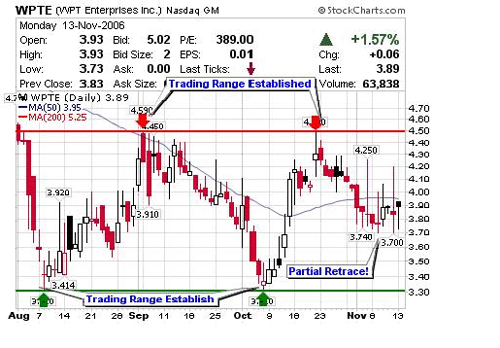 |
| Figure 3 |
| Source: StockCharts.com |
WPTE attempted to break out a week later and was ultimately rejected by the previous trading range. Nonetheless, buying the partial retrace netted a 15% gain in a week. It should be noted that it's not a bad idea to take profits at resistance due to the increased risk of buying in a base. As sellers were waiting at this established resistance area, excess supply began to force WPTE to drift back into the trading range after the failed breakout. Buyers returned in late January and early February at the same partial retrace area established earlier. While there were several false buy signals, it started becoming clear that WPTE was under accumulation in late January. The buy was a little over 3.80 again with a stop well under the partial retrace at 3.54.
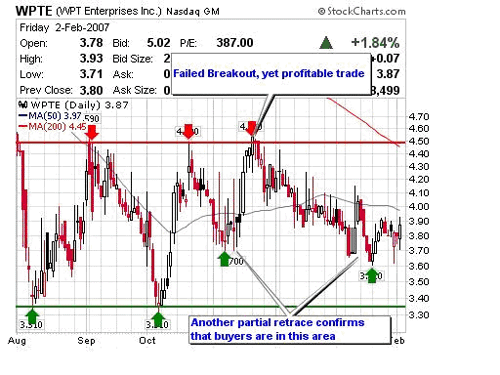 |
| Figure 4 |
| Source: StockCharts.com |
WPTE rocketed past resistance shortly thereafter, completing the breakout. Once it cleared the trading range, the trend changed to an uptrend. Notice the higher pivot highs and lows marked on the chart. WPTE was up over 50% in four weeks and it remained an open trade.
 |
| Figure 5 |
| Source: StockCharts.com |
Another Example
Qiao Xing Universal Telephone Inc. offers another example of a partial retrace. This time we are looking for a partial retrace within a pullback, rather than a lateral consolidation. There is no hard rule for what the base should look like, but the key is to look for a subtle change in an established range.
XING was making lower highs and lows (marked by the red arrows) throughout the latter part of 2006. Things changed in early 2007 as XING began making higher highs and lows (shown by the green arrows) after making a partial retrace. It was a partial retrace because it refused to make a lower low, which was the established trading range. Why were we looking for a partial retrace in this area? If you look toward the tail end of December, you will notice a gap higher that remained unfilled. Typically, gaps hold as support moving forward; this increased the odds that XING would complete a partial retrace in this area. XING continued to move higher quickly until it stumbled in late February.
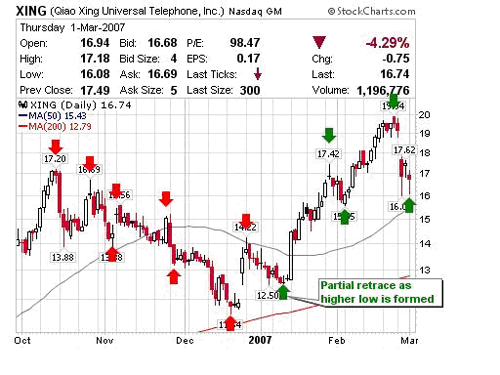 |
| Figure 6 |
| Source: StockCharts.com |
Summary
While there is much discretion to trading partial retraces, once the eye is trained to look for them, it can be a fairly reliable pattern to trade. While this type of trade may not feel natural at first, this is how professionals build positions every day. By getting in before a breakout, a trader can become the "smart money" and unload his or her shares to the usually late "retail" traders at resistance areas and after the breakout.
0 comments:
Post a Comment